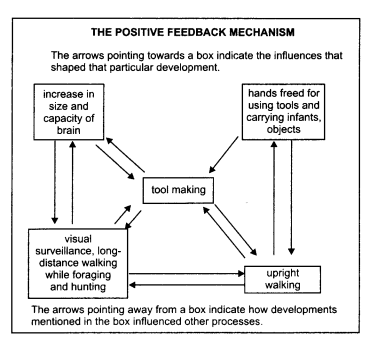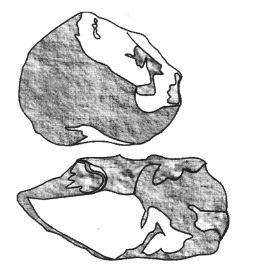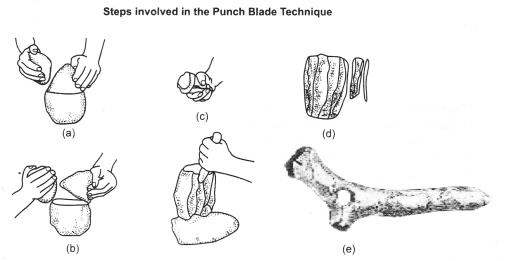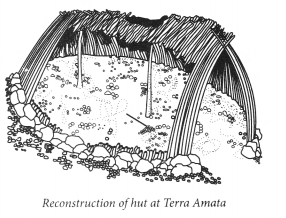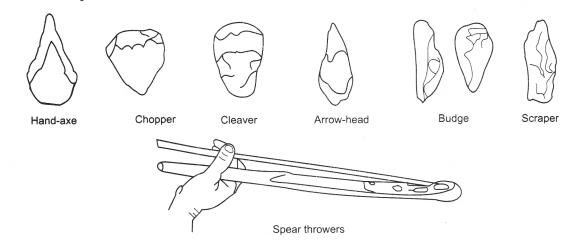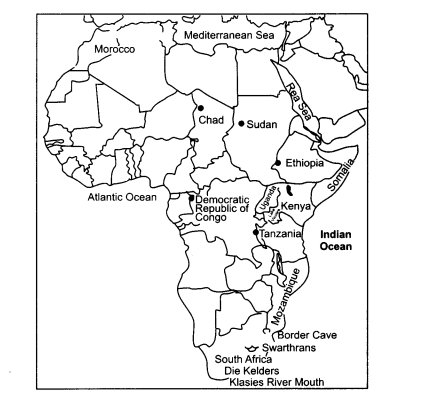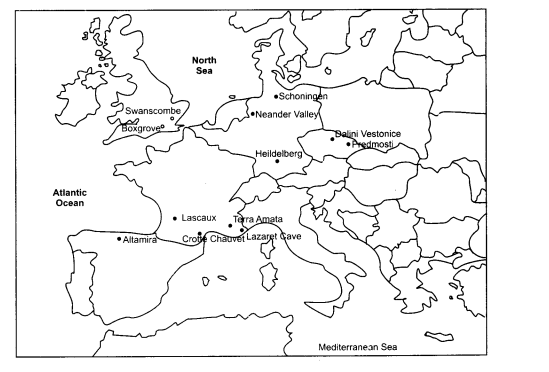
NCERT Solutions for Class 11 History Chapter 1: The NCERT Solutions for Class 11 History Chapter 1 can be found here. If you are a Class 11 student studying History with the NCERT Textbook, you will come across Chapter 1 Early Societies. Here you can find all of the NCERT Solutions for Class 11 History Chapter 1 Early Societies in one convenient location.
Students will have little trouble grasping the ideas. In a practical situation, students can rapidly comprehend and explain any of their questions. You may download the NCERT Solutions for Class 11 History Chapter 1 in PDF format to better grasp the solutions and improve your economic abilities. The PDF is available in both online and offline formats.
Access NCERT Solutions for Class 11 History Chapter 1
NCERT answers for class 11 aid students in strengthening their preparation, allowing them to achieve the maximum possible scores in the final examinations. These solutions strictly follow the CBSE’s most recent rules and curriculum.
NCERT Solutions for Class 11 History Chapter 1 include a variety of instructive examples to aid students in understanding and learning.
Question 1.Look at the diagram showing the positive feedback mechanism on page 13. (See NCERT Textbook). Can you list the inputs that went into tool making? What were the processes that were strengthened by tool-making?
After going through the positive feedback mechanism following points can be inferred:
(a) Inputs that helped in tool making:
- Increased brain size and capacity of brain
- Upright walking
- Visual surveillance long distance
- Walking while foraging and hunting.
(b) The processes that were strengthened by tool making:
- Upright walking
- Increase in size and capacity of brain
- Visual surveillance, long distance walking while foraging and hunting.
Question 2. Humans and mammals such as monkeys and apes have certain similarities in behavior and anatomy. This indicates that humans have possibly evolved from the . apes. List these resemblances in two columns under the headings of
(a) behavior and
(b) anatomy.
Are there any differences that are noteworthy?
Answer:
Similarities
(a) Behavior:
| Humans | Monkeys and Apes |
| 1. Humans can climb on trees. | Monkeys and apes can also climb on trees. |
| 2. Mothers give birth to their young ones. | Monkeys also give birth to their young ones. |
| 3. They can walk long distances. | They can also walk long distances. |
(b) Anatomy:
| Humans | Monkeys and Apes |
| 1. Humans are vertebrates. | 1. They are also vertebrates. |
| 2. Humans have two feet and two hands. | 2. Monkeys and apes are also quadrupeds. |
Question 3. Discuss the arguments advanced in favor of the regional continuity model of human origins. Do you think it provides a convincing explanation of the archaeological evidence? Give reasons for your answer.
According to the Regional Continuity Model, the Homo sapiens evolved in different regions at different rates into modern humans. So there was a variation in the first appearance of modern humans in different parts of the world. It was based on the regional differences in the features of present day humans. The advocates of this view found that the dissimilarities are due to the differences between the Homo erectus and Homo heidelbergensis populations of the same regions.
The Regional Continuity Model does not give a convincing explanation of the archaeological evidence.
Question 4. Which of the following do you think is best documented in the archaeological record: (a) gathering, (b) tool making and (c) use of fire?
Tool making is documented in the archaeological record.
Question 5. Discuss the extent to which: (a) hunting and (b) constructing shelters would have been facilitated by the use of language. What other modes of communication could have been used for these activities?
(a) Use of language helped hunting activities of human beings in numerous ways:
- Now people are in a position of organizing and managing hunting expeditions
- They are now free to exchange their ideas about different animals in different regions.
- They could now discuss the nature and behavior of animals.
- They could now discuss regarding the types of tools to be used.
(b) Language helped in constructing shelters for early humans in the following ways:
- Now people could discuss regarding secure and safe places for the construction of shelters.
- Now people could gather information about the materials used in the construction of shelter.
- Information regarding resources in and around their surroundings can be easily obtained.
- They were now in a position to discuss the means to protect their shelters in severe conditions.
Other modes: Signs, symbols, cave paintings, engraving on walls and on the ceilings of caves were the other modes of communication used for various activities
Question 6. Choose any two developments each from Timelines 1 and 2 at the end of the chapter and indicate why these are significant.
| Timeline 1 (mya) | |
| 36-24 mya | Primates; Monkeys in Asia and Africa |
| 24 mya | (Superfamily) Hominoids; Gibbons, Asian orangutan and African apes (gorilla, chimpanzee and bonobo or ‘pygmy’ chimpanzee) |
| 6.4 mya | Branching out of hominoids and hominids |
| 5.6 mya | Australopithecus |
| 2.6-2.5 mya | Earliest stone tools |
| 2.5-2.0 mya | Cooling and drying of Africa, resulting in decrease in woodlands and increase in grassland |
| 2.5-2.0 mya | Homo |
| 2.2 mya | Homo habilis |
| 1.8 mya | Homo erectus |
| 1.3 mya | Extinction of Australopithecus |
| 0.8 mya | ‘Archaic’ sapiens, Homo heidelbergensis |
| 0.19-0.16 mya | Homo sapiens (Modern humans) |
| Timeline 2 (years ago) | |
| Earliest evidence of burials | 300,000 |
| Extinction of Homo erectus | 200,000 |
| Development of voice box | 200,000 |
| Archaic Homo sapiens skull in the Narmada valley, India | 200,000 130,000 |
| Emergence of modern humans | 195,000 160,000 |
| Emergence of Neanderthals | 130,000 |
| Earliest evidence of hearths | 125,000 |
| Extinction of Neanderthals | 35,000 |
| Earliest evidence of figurines made of fired clay | 27,000 |
| Invention of sewing needles | 21,000 |
Developments from Timeline-1
- The evidence of the first Hominids was found about 5.6 mya. The Hominids evolved from Hominoids. They had some common features. Hominids had larger brain than Hominoids. Hominids had an upright posture and bipedal locomotion. There was a marked difference in regard to hand. It helped them in use of tools.
- Around 2.5 mya, large parts of the earth were covered with snow. There were major changes in the environment. It led to expansion of grassland.
Developments from Timeline-2
- Around 200,000 years ago, the evolution of the voice box took place. After the evolution of voice box, now the man was about to speak and express his views.
- About 27,000 years ago, the earliest evidence of figurines made of fired clay was also found. The invention of sewing machines made the life of people more comfortable.
Very Short Answer Type Questions
Question 1. Which sources enable us to understand the history of early humans?
The sources which enable us understand the history of early humans are stone tools, fossils, etc.
Question 2. What do you know about Carl Fuhlrott?
Carl Fuhlrott was a teacher and natural historian in Germany, Dusseldorf. He was handed over a skull and some skeletal fragments of early humans by workmen who were engaged in quarrying for limestone in the Neander valley region in August 1856.
Question 3. Name the book published by Charles Darwin. When was it published and what did he argue in it?
The book published by Charles Darwin was ‘ On the Origin of Species’. It was published on 24 November, 1859. In it, he argued about the evolution of mankind.
Question 4. Define ‘Fossils’.
The word ‘Fossils’ is used to describe the remains of very old plants, human beings or animals which have left their marks on the rock. These remains are preserved for many years.
Question 5. What are the two differences between Hominids and Hominoids?
The differences between Hominids and Hominoids are as follows:
- Hominoids have a smaller brain as compared to Hominids.
- Hominids have an upright posture and bipedal locomotion while Hominoids are quadrupeds.
Question 6. Write any two evidences that Hominoids have African origin.
Evidences which suggest that Hominoids have African origin are:
- A group of African apes is closely related to Hominoids.
- Early Hominoids have been found in East Africa dated back to 5.6 mya.
Question 7. To which family does Hominids belong to?
Hominids belong to Hominidae family. This family belongs to all forms of human beings existing on the earth.
Question 8. Describe in brief the distinctive features of Hominids.
The distinctive features of Hominids are as follows:
- They have large brain size.
- They have bipedal locomotion’s and upright posture.
Question 9. How will you differentiate Hominoids from monkeys?
Hominoids are different from monkeys in following ways:
- Hominoids have a larger body.
- They do not have tails like monkeys.
- There is a longer period of development and dependency amongst Hominoids.
Question 10. What are ‘Genus’? Name two important genus of Hominids.
Hominids are divided into different branches. They are known as genus. Two different genus of Hominids are Australopithecus and Homo.
Question 11. Define ‘Species’. How human species are differentiated from each other?
The term ‘Species’ is used to describe the group of organisms that can produce fertile offspring. Human species are differentiated from each other on the basis of the structure of their bones.
Question 12. When did glaciation phase come into being? What were its impact?
The glaciation phase is literally known as Ice Age. It came into being around 2.5 mya.
Impact:
- Temperature started decreasing.
- Grassland began to expand at the cost of forests.
Question 13. How have the fossils of human species been classified?
The fossils of human species have been classified by the scientists into three categories. These are:
- Homo habilis
- Homo erectus
- Homo sapiens.
Question 14. Name two places where the fossils of Homo habilis have been discovered.
The places where the fossils of Homo habilis have been discovered are:
- Omo (Ethiopia)
- Olduvai Gorge (Tanzania)
Question 15. Where were the fossils of earlier Homo erectus found?
They were found at following sites:
- Kenya
- Modjokerto
- Sangiran
- Java
Question 16. Give two examples where the names of the fossils are derived from. (HOTS)
- Homo heidelbergensis: The species of Homo heidelbergensis have been discovered from German city Heidelberg.
- Homo neanderthalensis: Its species have been found in Neander valley, Dusseldorf, a German city.
Question 17. The fossils of which Homo heidelbergensis have been widely distributed and where they are found? (HOTS)
The fossils of Homo heidelbergensis have been widely distributed. They are found in different parts of Africa, Asia and Europe.
Question 18. Write any two differences between Australopithecus and Homo.
Australopithecus and Homo are different from each other on account of the following reasons:
- Australopithecus has a smaller brain as compared to Homo.
- Australopithecus has heavier jaws and larger teeth as compared to Homo who have smaller jaws and teeth.
Question 19. Who were Primates? When did they come into existence?
Primates were a sub-group of a large group of mammals, i.e. monkeys, apes and humans. The Primates came into existence in about 36 mya.
Question 20. Write any two evidences to show that Hominids originated in Africa.
The following evidences suggest that Hominids originated in Africa:
- African monkeys are closely related to Hominids.
- Their earlier removing has been traced from Eastern Africa.
Question 21. What is meant by Australopithecus? Why are the earliest human called so?
The word Australopithecus is derived from Latin word ‘austral’ means southern and a Greek word ‘pithekos’ which means ‘apes’. Hence, the word means southern apes (Southern Monkey). The earliest human is called so because he resembles them.
Question 22. When and where were the traces of earliest Australopithecus found?
The traces of earliest Australopithecus were found from Olduvai Gorge by Mary and Louis Leaky on 17th July, 1959.
Question 23. How did early man obtain his food?
Early man obtained his food by gathering, hunting and fishing.
Question 24. When did hunting begin? From where do we get its earliest evidence?
Hunting began about 500,000 years ago. We get the earliest evidence of hunting from Box grove in Southern England.
Question 25. Where is Dolni Vestonice? Why is it famous for?
Dolni Vestonice is in Czech Republic. It is famous for hunting sites.
Question 26. What are artefacts?
Artefacts are man-made objects, which include several kinds of articles such as tools, paintings, sculptures, etc.
Question 27. When were the caves and open-air sites began to be used? From where do we get its evidence?
The caves and open-air sites began to be used around between 400,000 and 125,000 years ago. We get evidence of such sites from Lazaret cave in Southern France.
Question 28. What are the advantages of living in caves? (VBQ)
Advantages of living in caves are given below:
- It helped in protecting men from severe cold.
- It also protected them from the predators.
- It also protected them from the danger of wild animals.
Question 29. From where do we find the pieces of baked clay and burnt bone along with stone tools?
We find the pieces of baked clay and burnt bones from Chesowanja, Kenya and Swartkrans. These tools are dated between 1.4 and 1 mya.
Question 30. How did the discovery of fire help early man?
The discovery of fire helped early man in the following ways:
- It helped him cook his food.
- It helped him protect from the danger of wild animals.
Question 31. From where do we get the earliest evidence for making and use of stone tools? Who were earliest tool makers?
We get the earliest evidence for making and use of stone tools from two sites:
- Ethiopia
- Kenya
The Australopithecus were the first or earliest stone tool makers.
Question 32. How do we notice the improvement in the technique for making tools for hunting wild animals? When did such changes occur?
With the use of stone tools like spear throwers, bow and the arrow, we notice the improvement in technique for making tools. Such changes occurred around 35,000 years ago.
Question 33. When did spoken language emerge?
Spoken language emerged as early as 2 mya. Its emergence has been seen closely connected with art.
Question 34. Where is Altamira cave site? Who brought these caves into notice and when?
Altamira cave site is in Spain. The Altamira caves were brought into notice by Marcelino Sanz de Scutula and his daughter, Maria. The site came into notice in November 1879.
Question 35. Name a few places where cave painting depicting the pictures of animals have been found.
The cave painting depicting the pictures of animals such as bison, horses, deer, ma moths, lions, panthers, bear, owls, etc. have been found in Lascaux and Chauvet (Both in France) and in Altamira (in Spain).
Question 36. Define the concept of ‘Anthropology’.
It is a branch of science which deals with human culture and evolutionary aspects of human biology.
Question 37. Who was James Woodbum?
James Woodbum was a famous anthropologist. He gave a new insight to Hadza group in 1960.
Question 38. Where did Hadza group live? Write any two features.
The Hadza group lived around Lake Eyasi.
Features
- They were mainly hunters.
- They never claimed over land as its resources.
Question 39. What is Ethnography?
The study of contemporary ethnic groups is called Ethnography. It deals with examination of their modes of livelihood, rituals, customs and traditions.
Question 40. When did people of different corners of the world begin to learn domestication of plants and animals?
People of different corners of the world began to learn domestication of animals and plants around between 10,000 and 4,500 years ago.
Question 41. When did last Ice age come to an end? What was its result?
About 13,000 years ago, last Ice age came to an end. As a result of this favorable conditions for growing crops prevailed.
Question 42. Give reasons to prove why the people living in Hadza did not face food scarcity.
People living in Hadza did not face any food scarcity due to abundance of food items such as tuber, berries, fruits, etc.
Question 43. What were the dietary habits of Hadza group?
The dietary habits of Hadza group included wild tubes, meat and honey.
Question 44. List the wild animals hunted and consumed as meat by Hadza groups.
Hadza groups consumed the meat of zebra, giraffe, buffalo, shinoceor and waterduck, baboon, lion, leopard, hare and many more.
Class 11 History Chapter 1 Short Answer Type Questions
Question 1. What do you know about Java men? Why did scientists call them “The Erect Ape Men”?
The remains of Java men were first discovered by a Dutch surgeon in Java. It included-a skull, a thigh bone and two teeth. The study of these remains depicts that the Java was half ape and half man. It is because his head (Java man’s head) was set forward of the neck. The Java men were also called “The Erect Ape Men” by the scientists because they could walk erect.
Question 2. Who were Hominoids? When did they come into existence? Write their two unique characteristics.
- Hominoids were the subgroup of primates.
- They came into existence about 24 mya.
Characteristics
- They had smaller brain.
- They were unable to walk erect.
Question 3. Name two most important genus of Hominids. How they are different from each other?
Two most important genus of Hominids are, Australopithecus and Homo.
The major differences between them can be identified by the size of their brain, jaws and teeth. It may be summed up as:
- Australopithecus have a smaller brain as compared to Homo.
- Australopithecus have also larger jaws and teeth as compared to Homo.
Question 4. When and where do we get earliest evidence of bipedalism? What are the benefits of bipedalism? (HOTS)
We get the earliest evidence of bipedalism from Laetoli Tanzania. They are also obtained from Hadar, Ethiopia. They are as early as dated back to 3.6 mya.
Benefits of Bipedalism
- Bipedalism helped early men to see objects from far off distance.
- It helped themselves in protecting from animals.
- It became easier to distinguish them from others quadalism (Movement of a quadruped).
- Walk erect freed his two arms to carry out different tasks.
Question 5. What do you know about Replacement and Regional Continuity Models?
The Replacement Model supports the view that the modem human beings originated in a single region, i.e. Africa. In support of this view, most of the scholars tried to correlate the anatomical and genetic similarity of modern humans. It indicates that their ancestors belonged to one region and from where they migrated to different parts of the world.
The Regional Continuity Model supports the view that modem humans originated at several regions across Africa, Asia and Europe. To support their view the scholars tried to correlate the anatomical differences of modern humans which indicate that they belonged to different regions.
Question 6. Write any two features of Homo heidelbergensis and Homo neanderthalensis.
Two features of Homo heidelbergensis:
- They had a smaller brain.
- They had hairy growth on their body.
Two features of Homo neanderthalensis:
- They had much larger head,
- Their height was short.
Question 7. Explain the effects of changing environment around 12,000 years ago.
Around 12,000 years ago, there was a change in the climate of the world. There was an increase in the temperature of their environment. It resulted into the development of grasslands in many regions which in turn led to an increase in the number of animals that ate grass like deer, antelope, goat, sheep, cattle, etc.
Question 8. The tools of earlier humans were made of which materials. Which tools survived the most? Write its uses also.
Earlier humans used tools made of materials such as wood, stone and bones. The tools made of stones survived the most.
Uses of Stone Tools: These tools were used:
- To cut meat.
- To scrape barks of tree and skins of the animal.
- To chop fruit, roots and wood.
Question 9. Discuss the difficulties faced by early men to get their food.
The early men were food-gatherers not food producers. They faced following difficulties in collecting food:
- The danger of wild animals.
- Tools to hunt the animals were not good in quality.
- To hunt animals, they tend to be alert, quick and had a lot of presence of mind.
- They were unable to find which season the fruit ripened.
Question 10. Where do we get the earliest evidence of planned hunting? What did it depict?
We get the earliest evidence of planned hunting from European site Dolni Vestonice, Czech Republic. This site is nearby a river and it is believed that it was deliberately used by people. During the autumn and spring seasons reindeer and horse crossed the river and killed or hunted by early human on a large scale. The selection of such site depicted that the people were well aware about the movement of birds and animals and able to kill (hunt) them in large numbers.
Question 11. Trace the process of evolution of Homo habilis’s growth.
The fossils of Homo habilis are dated back to 2.2 mya to 1.8 mya. Their fossils have been found from Omo (Ethiopia) and Olduvali Gorge (Tanzania). The size of their brain was bigger and were considered more intelligent than Australopithecus. They were able to use their hands dexterously. They were the first to make tools of stone. Their tools helped a lot during their hunting expedition. Their mutual understanding during hunting expeditions led to the growth of language.
Question 12. How did the use of language prove advantageous in hunting expedition?
The use of language proved advantageous in hunting expedition in the following ways:
- It helped men in organizing hunting expeditions.
- Now they became aware about the nature of animals and discussed how to hunt those particular animals.
- They could collect information about the specific regions where these wild animals resided.
- They could share information regarding tools meant-especially for hunting expedition.
Question 13. How did the use of language prove valuable in the construction of shelters?
The use of language proved helpful in the construction of shelters in following ways:
- People could now secure places about their settlement.
- They became aware about resources available in near surroundings.
- They could discuss the ways of pattern of constructing their shelters.
- They could consider the ways and means to protect their shelters from predators and severe storms..
Question 14. What do you know about cave paintings at Altamira?
Altamira is a cave site in Spain. The paintings on the ceiling of the caves were first brought into notice of an amateur archaeologist Marcelino Sanz de Sautuola and his daughter Maria in November 1879. Maria suddenly noticed the paintings on ceiling when his father was busy in digging the floor of the cave. She brought these paintings to the notice of his father. At first looking of the picture of oxen, he just laughed, but soon he realized that some sort of paste rather than the paint has been used for painting. Two decades later, his findings were dismissed by European archaeologists on the ground that they did not appear too good to be very old.
Class 11 History Chapter 1 Long Answer Type Questions
Question 1. Write a description about the origin of human beings.
The story about the origin of human beings is very long and complicated. Different views in this regard have been given, and still the process of discoveries is going on. The chronological order of the number of events has changed due to new discoveries and excavations made so far. There is plenty of scope left for excavations. The early human passed through several stages of journey to become a modern man. The various stages which throw light on the story of progress made by man from the very beginning to the present days are given below.
- Primates: The early human came into being in Africa and Asia about 36-24 mya. They constitute a sub-group of a large group of mammals, such as monkeys, apes, and the humans. They had hair on their bodies and different kinds of teeth.
- Hominoids: They came into being about 24 mya. They had four legs and used to move on their four paws. The first portion of their bodies and legs were quite flexible but were unable to walk erect. Their body was different from the monkeys because they were comparatively larger and had no tail.
- Hominids: They belonged to Hominidae family and came into existence about 5.6 • mya. Their earliest fossils were excavated at Laetoli and Hader (both in Africa). It is a clear evidence that they originated in Africa. Their fossils were also found outside Africa.
Question 2. What do you know about early man’s tools and weapons made by them? Which techniques were used to make these tools?
Early man’s tools and weapons were made of stones. Early man used hard stones known as flint, along with other types of stones for making tools and weapons. Flint was the stone that was used for lighting fire. It was also found that these types of stones can be given desired shape. However, the tools that early man used were rough and unpolished. We get the earliest evidence for making and use of these stone tools from Ethiopia and Kenya. The Australopithecus were the first to make and use stone tools.
The stone tools were made by using following techniques:
- Stone on Stone: In this technique, the pebble from which the tool was to be made was held in one hand and the second stone was used to strike off flakes from the first.
- Pressure Flaking: In this technique, the core was placed on a firm surface. The hammer stone was used on a place of bone or stone that was placed on the core to remove flakes that could be shaped into tools.
- The Punch Blade Technique: In this technique, the top of a larger pebble is removed by using hammer stone to produce a flat surface. This flat surface, thus so produced, is called striking platform. This is then struck using a hammer and a punch made of bone. It then leads to the production of blades. It also leads to formation of knives.
Question 3. “Undoubtedly the modern man-made tremendous progress since coming into being.” Justify the statement. (HOTS)
Modern man had several peculiarities which made him different from his predecessors. Modern man is most intelligent in comparison to forefathers on account of the size of his brain. Modern man-made tremendous progress. He began to construct his huts in addition to the caves wherein he dwelled earlier.
He started to lead a settled life and began practicing agriculture. Now, he does not wander here and there in search of his food. He acquired knowledge how to cook food and also learnt how to store food grains and consumed it properly.
He began to store food grains for his future use or used it when required during the time of natural calamity. He also used much superior tools, which helped him to safeguard himself from the wild predatory more effectively. The invention of needle helped him to wear stitched clothes. The development in the field of art and language made him more superior. So we can conclude that the modern man made great achievements in comparison to his forefathers.
Question 4. Discuss in detail about the places of residence of early humans.
- The early humans lived on the branches of the trees. Between 400,000 and 125,000 years ago, the human beings began to live in caves and open air sites.
- We got the earliest evidence of living in caves from Lazaret cave in southern France. It measured 12 x 4 meters and revealed evidence of two hearths, several fruits, vegetables, seeds, nuts, eggs of animals and fishes.
- Dwelling in caves proved beneficial for him, as he could now protect himself from the danger of wild animals. Living in caves provided him natural refuge from severe stream and cold.
- The early humans began to live or dwell in huts around 125,000 years ago. It proved a significant step in early human’s journey towards progress.
- We get the most significant evidence of the hut constructed by early humans at Terra Amata in Southern France. It was made up of thatch and its roof was made up of wood Reconstruction of hut at Terra Amata stone-flakes scattered on the floor.
Question 5. Who were the first to use tools? How these tools used by early man were categorized?
Australopithecus were the first to use tools. About 35,000 years ago, we came across the evidence of a remarkable improvement in the method of hunting animals. It became clear from the event that a special type of spear was used to hunt animals.
The tools used by early man can be categorized into three types. They are discussed under following heads:
- Hand-axes: They were used for pouncing. In the beginning, they were used without a handle, but later on wooden handle was attached to it. It was made possible to use them with much force.
- Chopper: They were made of heavy stones worked to a sharp edge in one direction only, and were most probably used for chopping meat.
- Flake implements: They were used as knives and scrapers for finer works. For thousands of years of man’s early history the only remains that we find are crude stone tools. These tools are often found lying along the terraces of rivers, or in the huts or caves where early man used to live and roam in search of wild animals. These tools made by him served many purposes such as skimming of dead animals, cutting their flesh, etc.
About 35,000 years ago new kinds of tools such as spear throwers, bow and arrow came into being.

Question 6. Distinguish between Homo heidelbergensis and Homo neanderthalensis.
| Homo heidelbergensis | Homo neanderthalensis |
| (i) Their earliest fossils have been excavated from Heidelberg in Germany. | (i) Their earliest fossils have been excavated from Neander valley. |
| (ii) Their fossils were discovered in 1858. | (ii) Their fossils were excavated first in 1854. |
| (iii) Their fossils have been traced from Europe, Asia and Africa. | (iii) Their fossils have been traced from several countries across Europe, Western and Central Asia. |
| (iv) They had comparatively much larger brain, heavier jaws and much heavier limbs and hand. | (iv) They had much larger brain size. |
| (v) They had thick hair on the body. | (v) They also had similar features. |
| (vi) They belonged to Homo sapien species. | (vi) They also belonged to Homo sapien species. |
| (vii) They used to live in caves. | (vii) They used to dwell in caves. |
| (viii) Their fossils existed from 0.8-0.1 mya. | (viii) They existed from 130,000 to 35,000 years ago. |
Question 7. How did early man procure his food? Explain.
The early man procured his food through a number of ways. Some of the ways are listed below:
Gathering: For his food items, early man was totally dependent on nature. He was a pastoralist nomad, who kept on wandering. In the very beginning, he was a food-gatherer. He gathered eatables from trees and plants. The main food items were seeds, nut, fruit, etc. All these food items could be preserved. There is lack of evidence. The prominent role in food-gathering was played by women and children.
Scavenging: The early man also procured his food through scavenging. They used to obtain food from the carcasses of those animals which had died naturally or had been killed by other larger animals. They were used to eat the meat of small birds, eggs and several kinds of insects.
Hunting: To procure food through hunting was also one of the best methods of obtaining food. Hunting was mainly the domain of menfolk. They used to hunt the small animals individually, but in case of the hunting of large animals, group efforts were the key to success.
They hunted wild animals such as wild horses, wild buffaloes, rhinoceros, bear, etc. They used spears and tools made of stone to hunt wild animals. We get the earliest evidences of well planned hunting and butchery of large animals from Box grove in Southern England and Schoningen in Germany. About 35,000 years ago, there is some evidence of planned hunting that comes from European sites.
One such site of planned hunting is Dolini Vestonice in Czech Republic. This site was situated in close proximity to a river, where a number of animals came to drink water. Horses and reindeers were used to come here to drink and cross the river during autumn and spring migrations. Then they were hunted on large scale, by the early humans who were well aware about their movement.
Fishing: Early man also obtained his food by fishing. They caught fish from rivers and ponds with their hands. Later on hooks and harpoons for catching fishes came into use.
Question 8. Discuss the progress made by early man in the field of art.
The early man was much interested in the field of art. He found that art is a unique
method to express his feelings. So, he tried his hands both in paintings and sculptures.
(i) Paintings: In the very beginning, the early man tried to express every thing which impressed him in his daily life. He was much impressed by seeing (observing) natural beauty, i.e. flora and fauna, the sun, the moon, stars, rivers, etc. and also fond of hunting. Hunting was the part of his daily routine.
So he painted many pictures depicting the hunting theme. The paintings depicting hunting theme have been envisaged on the wall of the caves and ceiling on the walls. For example, the caves of Altamira, Lascaux, and Chauvet are specially well known. Altamira caves were discovered by Marcelino Sanz de Sautuola and his daughter in 1879.
- Lascaux and Chauvet caves came into limelight in 1894. These caves have plenty of beautiful pictures.
- Most of these paintings are of horses, bison’s, mammoths, bears, leopards, owls, etc. Black, red, yellow and white colors have been widely used for engraving these paintings. A number of questions have been put forward regarding the above mentioned paintings.
- Scholars have different opinions in this regard. Some scholars are of the view that they painted these pictures to beautify the walls and ceilings on the caves while others put forward their argument as they did so to pass their knowledge from one generation to another.
(ii) Sculpture: Small-sized statues were built by early man, representing humans and animals. Most of the human statues were of women and recovered from several places in Europe. These female statues are called Venus goddess.
Class 11 NCERT Chapter 1 Passage Based Questions:
Read the following passages carefully and answer the questions that follow:
Passage 1.
The Discovery of Australopithecus, Olduvai Gorge, 17 July, 1759
The Olduvai Gorge was first ‘discovered’ in the early twentieth century by a German butterfly collector. However, Olduvai has come to be identified with Mary and Louis Leakey, who worked here for over 40 years. It was Mary Leakey who directed archaeological excavations at Olduvai and Laetoli and she made some of the most exciting discoveries. This is what Louis Leakey wrote about one of their most remarkable finds:
That morning I woke with a headache and a slight fever. Reluctantly, I agreed to spend the day in camp. With one of us out of commission, it was even more vital for the other to continue the work, for our precarious seven-week season was running out.
So Mary departed for the diggings with Sally and Toots [two of their dogs] in the Land- Rover [a jeep-like vehicle], and I settled back to a restless day off. Some time later-perhaps I dozed off-I heard the Land-Rover coming up fast to camp. I had a momentary vision of Mary stung by one of our hundreds of resident scorpions or bitten by a snake that had slipped past the dogs.
The Land-Rover rattled to a stop, and I heard Mary’s voice calling over and over: “I’ve got him! I’ve got him! I’ve got him!” Still groggy from the headache, I couldn’t make her out. “Got what? Are you hurt?” I asked. “Him, the man! Our man,” Mary said. “The one we’ve been looking for 23 years. Come quick, I’ve found his teeth!”
Questions:
(i) Where were the fossils of Australopithecus discovered? Who discovered it?
(ii) When did they (Australopithecus) originate and become extinct?
(iii) Describe any three features of Australopithecus.
Answers:
(i) The fossils of Australopithecus were discovered from Olduvai Gorge on 17 July, 1759. These fossils were discovered by Mary Leakey, the director of Archaeological Excavation at Olduvai and Laetoli.
(ii) Australopithecus originated in about 5.6 mya and became extinct about 1.3 mya.
(iii) Features of Australopithecus:
- Heavier jaws
- Bigger teeth
- Dwelling on trees. The Hadza
Passage 2.
‘The Hadza are a small group of hunters and gatherers, living in the vicinity of Lake Eyasi, a salt, rift-valley lake…The country of the eastern Hadza, dry, rocky savanna, dominated by thorn scrub and acacia trees…is rich in wild foods. Animals are exceptionally numerous and were certainly commoner at the beginning of the century.
Elephant, rhinoceros, buffalo, giraffe, zebra, waterbuck, gazelle, warthog, baboon, lion, leopard, and hyena are all common, as are smaller animals such as porcupine, hare, jackal, tortoise and many others. All of these animals, apart from the elephant, are hunted and eaten by the Hadza. The amount of meat that could be regularly eaten without endangering the future of the game is probably greater than anywhere else in the world where hunters and gatherers live or have lived in the recent past.
Vegetable food-roots, berries, the fruit of the baobab tree, etc.-though not often obvious to the casual observer, is always abundant even at the height of the dry season in a year of drought. The type of vegetable food available is different in the six- month wet season from the dry season but there is no period of shortage. The honey and grubs of seven species of wild bee are eaten; supplies of these vary from season-to-season and from year-to-year.
Sources of water are widely distributed over the country in the wet season but are very few in the dry season. The Hadza consider that about 5-6 kilometers is the maximum distance over which water can reasonably be carried and camps are normally sited within a kilometer of a water course.
Part of the country consists of open grass plains but the Hadza never build camps there. Camps are invariably sited among trees or rocks and, by preference, among both.
The eastern Hadza assert no rights over land and its resources. Any individual may live wherever he likes and may hunt animals, collect roots, berries, and honey and draw water anywhere in Hadza country without any sort of restriction.
In spite of the exceptional numbers of game animals in their area, the Hadza rely mainly on wild vegetable matter for their food. Probably as much as 80 per cent of their food by weight is vegetable, while meat and honey together account for the remaining 20 per cent.
Camps are commonly small and widely dispersed in the wet season, large and concentrated near the few available sources of water in the dry season. There is never any shortage of food even in the time of drought.
Questions
(i) What do you know about Hadza group?
(ii) Describe the dietary habits of Hadza group.
(iii) “People of Hadza group did not face food scarcity during dry season.” Why?
(iv) Why did people of Hadza group not claim their right over land and its produce?
Answers
(i) The people of Hadza group were hunters and gatherers who did claim their right over the land and its produce.
(ii) Their dietary habits comprised:
- Wild tuber (80%)
- Meat and honey (20%)
- They ate the meat of animals such as hare, jackal, hyena, warthog, baboon, gazelle, etc. but did not eat the meat of elephant.
(iii) People of Hadza did not face any food scarcity during dry season, because there was no shortage of food articles like berries, tuber, fruits, etc.
(iv) The people of Hadza did not claim their rights over land and its produce because:
- They resided wherever they liked to reside.
- They were free to hunt wild animals.
- Without any restriction, they could collect tuber and honey.
Class 11 History Chapter 1 Map Skills
Question 1.
On the map of Africa mark and locate the sites related to early humans.
(i) Chad
(ii) Sudan
(iii) Ethiopia
(iv) Tanzania
(v) Democratic Republic of Congo
(vi) Mozambique. On the given map of Europe locate the places (sites) from where the fish bones have been found.
Answer:

Question 2.
On the given map of Europe locate the places (sites) from where the fish bones have been found.
Answer:
Access Other Chapters of NCERT Solutions of Class 11 History–
For additional Chapters, you may get the PDF of NCERT Solutions Class 11 History:
- Chapter 2
- Chapter 3
- Chapter 4
- Chapter 5
- Chapter 6
- Chapter 7
- Chapter 8
- Chapter 9
- Chapter 10
- Chapter 11
Best wishes to all students taking the Class 11th exam. Here is the detailed blog of NCERT Solutions for Class 11 History Chapter 1. You can ask any questions you have about the CBSE Class 11th test in the comment section.
FAQs on NCERT Solutions for Class 11 History Chapter 1
Is it possible to watch NCERT Solutions for Class 11 History Chapter 1 while I’m not connected to the internet?
Yes, you can watch NCERT Solutions for Class 11 History Chapter 1 even if you don’t have access to the internet.
What does it cost to obtain NCERT Solutions for Class 11 History Chapter 1 PDF?
It is completely free to access NCERT Solutions for Class 11 History Chapter 1 PDF.
Where can we get the PDF for NCERT Solutions for Class 11 History Chapter 1?
The link to download the PDF is available in the above blog for NCERT Solutions for Class 11 History Chapter 1 PDF.
Are NCERT Solutions for Class 11 History Chapter 1 sufficient for test preparation?
Yes, the information on KopyKitab about NCERT Solutions for class 11 History Chapter 1, which includes full study resources, is sufficient for students to prepare for and pass their examinations.
Which website provides the most up-to-date CBSE prescribed curriculum as well as books for great History exam preparation materials for class 11?
For full preparation for class 11 History examinations, KopyKitab gives the newest CBSE-approved syllabus and materials. The study materials are always available in PDF format, which may be downloaded at any time.
